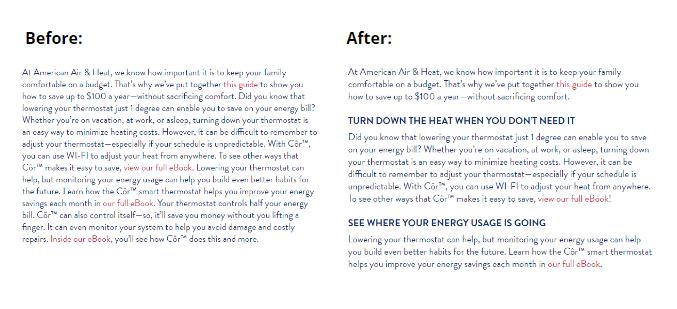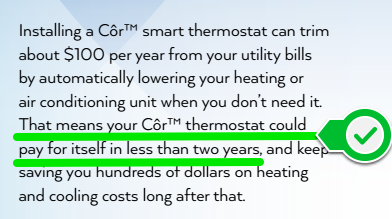Let’s face it: Writing about accounting software or air conditioners isn’t as alluring as writing about fashion, food, or travel.
But that’s no excuse to create content that puts people to sleep. On the contrary, content for “boring” industries can be incredibly engaging and shareable.
In this article, I’ll show you how I create interesting content for boring industries. (I taught middle school science for 4 years, so I know a thing or two about making seemingly boring topics come alive.)
1. It’s not your job to be entertaining. It’s your job to be relevant.
Much like middle schoolers, your customers don’t care what you have to say — even if you sing and dance — unless it’s relevant to them.
Take thermostats for example. Thermostats are excruciatingly boring. No one reads about thermostats to be entertained. People read about thermostats when they get a $200 electric bill. That’s why my article on “Making the Most of Your Thermostat” was shared over 1,500 times:
But don’t take my word for it: this study from the New York Times Consumer Insight Group found that “entertainment” was the least common reason people shared content.
Instead, brands should focus on creating relevant content that solves a problem for their audience. You do that by:
-
- Asking your sales or support team about common questions, concerns, or objections
- Attending industry conferences to hear what people are talking about
- Participating in LinkedIn groups for your industry
- Using Google autocomplete to see what people are searching for
- Reading comments on industry blogs and using your content to join in on the conversation
- Scanning review sites for common complaints about products/services in your industry
- Browsing Quora for popular questions your audience is asking
2. Pick a fight.
Unless you want to sound like Charlie Brown’s teacher, you need to find a new angle on your content. Instead of saying the same things as everyone in your industry, pick a fight with a commonly held belief you disagree with. Be sure to back up your opinion with lots of proof. (Remember, controversy is good — but don’t be controversial just for the sake of it.)
Here are a few controversial headline ideas to get you started:
-
- The Surprising Truth About [Your Topic]
- The Worst Advice on [Your Topic] We’ve Ever Read
- 5 Mistakes Most People Make When [Your Topic]
- 7 Little Known Ways to [Your Topic]
- 10 Common Myths About [Your Topic]
- 21 Lies About [Your Topic] the “Experts” Made You Believe
3. Keep it simple.
Using long, complicated words and industry jargon doesn’t make you sound smart. It doesn’t make you look like an expert. In fact, it may have exactly the opposite effect.
A study by Princeton University concluded that using big words where simpler ones will do makes it more difficult for the reader to understand the text and lowers their opinion of the writer. Readers who were given complex, flowery writing samples consistently rated the authors as less intelligent than those that used simple, clear language.
4. Give concrete examples.
The easiest way to make your writing simpler? Give concrete examples. Don’t just tell your readers your product will “save money”. Show them in dollars how much money they’ll save, and what that means — like in this example:
5. Break up walls of text.
Even if your writing is engaging, no one will read it if it looks like a giant essay.
Make your content enjoyable to read by breaking up large blocks of text. You can do that by adding headlines and subheads, splitting long paragraphs, inserting images, and adding special formatting like bold or italics.
Compare the two blocks of text below. Which one is easier to read?

Small screens make text spacing even more important. Remember that many people will be consuming your content on a mobile phone or tablet. A massive wall of text will look especially overwhelming on these tiny screens.
So how often should you break up your text? As a rule, I don’t like to go more than 4-5 lines without adding white space. This gives your writing some breathing room and makes it easier on the eye.
6. Use pictures.
According to Purdue University, 65% of people are visual learners. So visual content — like a video, infographic, image, or chart — is helpful when it comes to making your content stick. (On the other hand, if your visual content is rotten tomatoes, it can do more harm than good.)
Fortunately, it’s not hard to create stunning visuals in a snap. Here are some of the best free tools:
- Infographics: Piktochart
- Graphics: Canva
- Screenshots: Skitch
- Stock photos: Pixabay
- Video hosting: Wistia
- Memes: Imgflip
So here’s the recap:
-
- Be relevant by answering the questions your customers ask.
- Pick a fight with a commonly held belief.
- Keep your writing clear and simple.
- Give concrete examples to support your point.
- Use pictures, infographics, and video in place of (or alongside) text.
- Break up walls of text into readable chunks with headlines, paragraphs, and images.
Do you work in a “boring” industry? How do you keep your content interesting?



 I'm Christine Lellis, a copywriter and certified content marketer from Michigan.
I'm Christine Lellis, a copywriter and certified content marketer from Michigan.